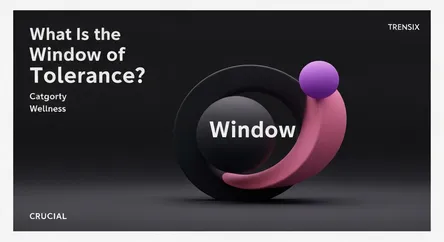Wellness
What Is the Window of Tolerance?

Learn about the 'window of tolerance,' the optimal zone for managing stress, and how it impacts your emotional well-being and daily functioning.
What is it?
The "window of tolerance" is the optimal zone of arousal where you can effectively manage emotions and handle stress. Coined by Dr. Dan Siegel, this concept describes the mental state where you feel grounded, present, and able to think clearly. When pushed outside this window by stressors, you can enter a state of "hyperarousal" (fight-or-flight), feeling anxious, angry, or overwhelmed. Conversely, you might enter "hypoarousal" (freeze), feeling numb, disconnected, or shut down. Staying within the window allows you to navigate life’s challenges without becoming dysregulated.
Why is it trending?
The concept is gaining popularity in wellness and mental health because it offers a simple framework for understanding emotional regulation. It is a key tool in trauma-informed care, helping individuals with conditions like PTSD understand their reactions to triggers. The window of tolerance normalizes physiological responses to stress, reducing shame and empowering people to track their own arousal states. As society places a greater emphasis on mental health and mindfulness, this model provides an accessible way for anyone to build self-awareness and improve their resilience to stress.
How does it affect people?
Each person's window of tolerance is different and can be narrowed by factors like trauma, stress, or neurodivergence. A narrow window means a person may be more easily pushed into hyper or hypoarousal by everyday events. By understanding this concept, people can identify personal triggers and recognize the physical and emotional signs of leaving their window. This awareness allows them to use grounding and mindfulness techniques to return to a state of balance. The goal is to gradually widen the window, increasing one's capacity to handle stress and remain engaged and effective in life.